
- Select a language for the TTS:
- UK English Female
- UK English Male
- US English Female
- US English Male
- Australian Female
- Australian Male
- Language selected: (auto detect) - EN
Play all audios:
FILE - This Jan. 9, 2014, file photo shows a mockup of a Minuteman 3 nuclear missile used for training by missile maintenance crews at F. E. Warren Air Force Base, Wyo. The Air Force is
quietly shrinking its deployed force of long-range nuclear missiles as part of a holdover Obama administration plan to comply with an arms control treaty with Russia, The Associated Press
has learned. The plan is proceeding despite President Donald Trump’s argument that the deal gave Moscow an unfair advantage in strategic nuclear firepower. (AP Photo/Robert Burns, File) (The
Associated Press) WASHINGTON – The Air Force is quietly shrinking its deployed force of land-based nuclear missiles as part of a holdover Obama administration plan to comply with an arms
control treaty with Russia. The reductions are nearing completion despite President Donald Trump's argument that the treaty gives Moscow an unfair advantage in nuclear firepower. The
reduction to 400 missiles from 450 is the first for the intercontinental ballistic missile, or ICBM, force in a decade — when the arsenal came down from 500 such weapons. The Air Force says
the latest cut in Minuteman 3 missiles will be completed in April, leaving the deployed ICBM arsenal at its smallest size since the early 1960s. In 2014, President Barack Obama's
administration announced the planned ICBM reduction to tailor the overall nuclear force, including bombers and nuclear-armed submarines, to the New START accord that the U.S. and Russia
sealed in 2010. Both nations must comply with the treaty's limits by February 2018. The shrinking of the ICBM force runs counter, at least rhetorically, to Trump's belief that the
U.S. has fallen behind Russia in nuclear muscle. In December, he tweeted that the U.S. must "greatly strengthen and expand its nuclear capability until such time as the world comes to
its senses regarding nukes." He has criticized New START as a bad deal. It's unclear how Trump intends to conduct a nuclear expansion, which critics call unnecessary and a
potential drain on funds needed for non-nuclear forces. A long-term plan to replace and modernize the current nuclear force is already underway and will end up costing hundreds of billions
of dollars. As of March 14, the Air Force had 406 Minuteman missiles in launch-ready silos, Maj. Daniel Dubois, an Air Force spokesman, said Friday. In September the number was 417. Dubois
said the number will be down to 400 by April. Also as part of the treaty's compliance process, the Air Force in January finished converting 41 B-52H bombers to non-nuclear status.
Michaela Dodge, a defense policy analyst at the conservative Heritage Foundation think tank, says the U.S. should get out of New START. "There should be a way to reverse those
decreases," she said, referring to the 50 Minuteman missiles pulled out of their silos. "As long as Russia continues to increase the number of its nuclear warheads under New START,
we should not be decreasing." Russia's warheads have surpassed the treaty limit of 1,550, and the U.S. is below the limit. But by next February, neither is expected to be above.
Daryl Kimball, executive director of the Arms Control Association, said Moscow would honor its New START commitment. "It's important for the United States to stay on
schedule," he said, arguing that such efforts "will help ensure that Russia does the same." Based on military calculations, Obama declared in 2013 that the U.S. could safely
reduce its nuclear force by one-third from New START levels. But negotiations to do so never took place. They seem even unlikelier after Russia's military actions in Ukraine and Kremlin
rhetoric that U.S. officials have considered reckless and dangerous. However, Trump's suggestions of interest in a grand bargain with Russia, including nuclear reductions, could
provide an avenue for fresh talks. After taking office, Trump ordered a review of nuclear forces, a Pentagon-led process likely to take a year or more. Among the key questions: whether to
continue Obama's weapons modernization plan and a possible withdrawal from New START. One element of the modernization plan calls for a new-generation ICBM force that could cost more
than $100 billion. Sticking with New START would not necessarily constrain the U.S. for long. It expires in February 2021 unless both sides agree on an extension. Besides the overall warhead
limit, the treaty allows each side a maximum of 700 deployed launchers, including missile silos. Russia and the United States can decide for themselves how their totals are apportioned
among the three weapons categories: ICBMs, submarines and bombers. The 50 underground silos from which the Minuteman missiles are being removed will be kept "warm," meaning capable
of returning to active use. The missiles are being put in storage. Those decisions came after members of Congress from the ICBM base states — North Dakota, Wyoming and Montana — pushed for
no elimination of silos. The 400 remaining deployed ICBMs would be the fewest since 1962, according to a history of the force written by Hans Kristensen of the Federation of American
Scientists.






:max_bytes(150000):strip_icc():focal(999x0:1001x2)/amazon-fires-1-2000-68cc86300b964ad591b356d65f858295.jpg)

